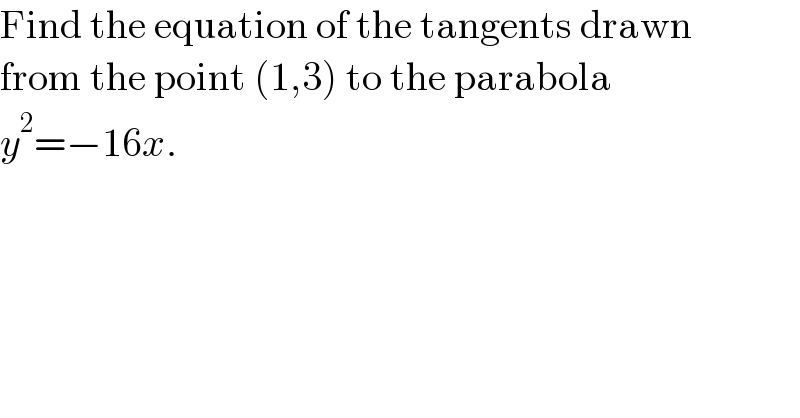Question Number 157487 by ZiYangLee last updated on 23/Oct/21

$$\mathrm{Find}\:\mathrm{the}\:\mathrm{equation}\:\mathrm{of}\:\mathrm{the}\:\mathrm{tangents}\:\mathrm{drawn} \\ $$$$\mathrm{from}\:\mathrm{the}\:\mathrm{point}\:\left(\mathrm{1},\mathrm{3}\right)\:\mathrm{to}\:\mathrm{the}\:\mathrm{parabola} \\ $$$${y}^{\mathrm{2}} =−\mathrm{16}{x}. \\ $$
Answered by mr W last updated on 23/Oct/21
![say the tangent line is x=1+k(y−3) y^2 =−16[1+k(y−3)] y^2 +16ky+16(1−3k)=0 it should have only one root. (16k)^2 −4×16(1−3k)=0 4k^2 +3k−1=0 (4k−1)(k+1)=0 ⇒k=−1, (1/4) x=1−(y−3) ⇒y=−x+4 x=1+((y−3)/4) ⇒y=4x−1](https://www.tinkutara.com/question/Q157490.png)
$${say}\:{the}\:{tangent}\:{line}\:{is} \\ $$$${x}=\mathrm{1}+{k}\left({y}−\mathrm{3}\right) \\ $$$${y}^{\mathrm{2}} =−\mathrm{16}\left[\mathrm{1}+{k}\left({y}−\mathrm{3}\right)\right] \\ $$$${y}^{\mathrm{2}} +\mathrm{16}{ky}+\mathrm{16}\left(\mathrm{1}−\mathrm{3}{k}\right)=\mathrm{0} \\ $$$${it}\:{should}\:{have}\:{only}\:{one}\:{root}. \\ $$$$\left(\mathrm{16}{k}\right)^{\mathrm{2}} −\mathrm{4}×\mathrm{16}\left(\mathrm{1}−\mathrm{3}{k}\right)=\mathrm{0} \\ $$$$\mathrm{4}{k}^{\mathrm{2}} +\mathrm{3}{k}−\mathrm{1}=\mathrm{0} \\ $$$$\left(\mathrm{4}{k}−\mathrm{1}\right)\left({k}+\mathrm{1}\right)=\mathrm{0} \\ $$$$\Rightarrow{k}=−\mathrm{1},\:\frac{\mathrm{1}}{\mathrm{4}} \\ $$$${x}=\mathrm{1}−\left({y}−\mathrm{3}\right)\:\Rightarrow{y}=−{x}+\mathrm{4} \\ $$$${x}=\mathrm{1}+\frac{{y}−\mathrm{3}}{\mathrm{4}}\:\Rightarrow{y}=\mathrm{4}{x}−\mathrm{1} \\ $$
Commented by mr W last updated on 23/Oct/21

Answered by cortano last updated on 24/Oct/21

$${let}\:\left({x},{y}\right)\:{is}\:{contact}\:{point}\:{of}\:{tangent} \\ $$$${line}\:.\:{we}\:{have}\:\begin{cases}{{m}={y}'=−\frac{\mathrm{8}}{{y}}}\\{{m}=\frac{{y}−\mathrm{3}}{{x}−\mathrm{1}}=\frac{{y}−\mathrm{3}}{−\frac{{y}^{\mathrm{2}} }{\mathrm{16}}−\mathrm{1}}}\end{cases} \\ $$$${then}\:−\frac{\mathrm{8}}{{y}}=−\frac{\mathrm{16}\left({y}−\mathrm{3}\right)}{{y}^{\mathrm{2}} +\mathrm{16}} \\ $$$$\Rightarrow{y}^{\mathrm{2}} +\mathrm{16}=\mathrm{2}{y}\left({y}−\mathrm{3}\right) \\ $$$$\Rightarrow{y}^{\mathrm{2}} +\mathrm{16}=\mathrm{2}{y}^{\mathrm{2}} −\mathrm{6}{y} \\ $$$$\Rightarrow{y}^{\mathrm{2}} −\mathrm{6}{y}−\mathrm{16}=\mathrm{0} \\ $$$$\Rightarrow\left({y}−\mathrm{8}\right)\left({y}+\mathrm{2}\right)=\mathrm{0} \\ $$$$\:\begin{cases}{{y}=\mathrm{8}\rightarrow{x}=−\mathrm{4}}\\{{y}=−\mathrm{2}\rightarrow{x}=−\frac{\mathrm{1}}{\mathrm{4}}}\end{cases} \\ $$$${we}\:{get}\:{two}\:{of}\:{tangent}\:{line}\:{are} \\ $$$$\:\begin{cases}{{at}\:\left(−\mathrm{4},\mathrm{8}\right)\:\Rightarrow{m}=−\mathrm{1};\:{x}+{y}=\mathrm{4}}\\{{at}\:\left(−\frac{\mathrm{1}}{\mathrm{4}},−\mathrm{2}\right)\Rightarrow{m}=\mathrm{4}\:;\:\mathrm{4}{x}−{y}=\mathrm{1}}\end{cases} \\ $$
